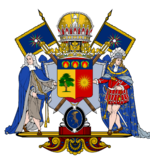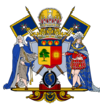Duchy of Audentior
| Duchy of Audentior Ducal Confederation of Audentior Audente Confederation The Blue Sun Belt of Kildare | |||
| Subdivision of | |||
| |||
|
File:Map Audentior.png | |||
| Motto | The power of the Sun! | ||
| Anthem | All hail Apollonia! | ||
| Subdivision | Duchy (Tier I) | ||
| Capital | Xiacheng (Apollo City) | ||
| Largest cities | Xiacheng, Kaimingcheng, Chuan Ke, Hongang, Zhengjiangcheng | ||
| Area | 68.102 km2 | ||
| - Ranked | |||
| Population | 109,313,254 (1717 AN) | ||
| - Ranked | |||
| Duke | Hon ben Gyoku | ||
| Legislature | Seanad of the Confederation | ||
| Established | 1715 AN | ||
| Languages | Præta and Jingdaoese (official), Istvanistani (administrative) | ||
| Local religion | |||
| Abreviation | DA | ||
| Time Zone | |||
The Audente Confederation, also known as the Ducal Confederation of Audentior or simply the Duchy of Audentior, is a territory within the Imperial Republic of Shireroth. It emerged in 1715 AN after a conflict between the Duke of Raynor's Isles on one side and and the Viceroy of Hondon and Duchess of Outer Antya on the other side. This event marked the end of the Feudatory Feud and led to the consolidation of two duchies into one. The name Audentior has roots in the area's rich history, being linked to the ancient Apollantis and Audentior Independent Nation (which was both an independent empire and later a province of the Apollonian Republic).
History
Let it be clear that the research into the history of Audentior, just like other parts of Greater Kildare, has been heavily influenced by the Greater Jing School: where the Kildari of old meticulously gathered their sources, wrote them down and eagerly awaited answers from the God Sakat, many of those practices were replaced in favour of a more chauvinist and jingdaoified version of history during the 17th century.
Whatever may have happened, the history of Audentior can be traced back to the early beginnings of modern civilisation on Micras. The old Duchy of Kildare called itself 'Birthplace of Modern Civilisation' with a reason, as it was an established fact that the region had known civilisation which preceded that of their conquerors, the Shirerithians.
The fertile lands of the Hondon region around Xiacheng (Apollo City) provided favorable living conditions. It was here that around 1500bAN the first nomads settled as farmers, near the mouth of the Antya River. Its population grew and with domestication of grain and animals eventually came the first cities. The city of Xiacheng successfully challenged the other towns for hegemony, leading to the creation of the first nation in Micras' history: the so-called Empire of the Glorious Sun.
During the 4th century bAN, a mythological emperor of Jingdaoese descent would have united eight tribes, which had been living at the periphery of the Hondon region. This warlord, later known as the Ying Emperor used the dissatisfaction of the populace and tribal people to march onto Xiacheng and carve out an empire of his own. This Empire of the Pure Path, divided into a Zuxiang Dynasty (351 bAN - 264 AN) and Wangzi Dynasty (265 - 987 AN), would expand across the coastline and Antya River.
While many historians are doubtful about precise details and even openly started criticizing the existence of a Jingdaoese line of emperors, they agree that it overlapses with the migration of several tribes to other territories (even going as far as the Isle of Melangia). Batavian historical texts, about the migration of Batavian ancestors from the far east (the Antya River region) to their current homelands in Batavia, coincide with this time period. A religious scripture about the Tower of Airosamente, in which the overconfident people from Xiacheng (Airosamente back in those days) constructed a huge tower to honour the emperor and their gods. The Tower eventually bled the empire economically dry, leading to its collapse: one wonders if this was the cataclysm which led to the replacement of the Zuxiang Dynasty with the Wangzi Dynasty in 265 AN. In turn it would have explained the sudden migrations.
The 10th century AN saw a definitive fracturing of a centralised empire into minor warring states. It's the start of what Shirerithian experts describe as the beginning of the Apollonian states. The Greater Jing scholars refer to it as the Youya Dynasty (despite lacking a 'dynasty' to rule it properly). The Union of Apollo States was established in 1450 AN, which brought a semblance of unity to the region: by now, the Apollonian peoples governed lands which stretched to the current-day northern borders of Dalmacija.

The Union was shortlived, as Kaiser Gaelen I swiftly crushed any Apollonian armies and resistance. In 1451 AN he landed on the coast, near Gaelen's Landing and subdued the people he came across with. From 1451 to 1623 AN, the territories became part of the Imperial Republic. However, the overextended armies of Shireroth failed to permanently hold Xiacheng and the surrounding region. The Seanad (or whatever was left of it in those chaotic days) of the Union of Apollo States, surrendered the lands west of the Antya River to the Kaiser. Confonted with resistance in the north, Gaelen accepted. But not without assuring that resistance in Audentior was properly broken. Several punitive expeditions were undertaken by Shirerithian forces, to avoid a resurgence of Apollonian resistance. The lands east of the Antya River remained free from Shirerithian influence, with exception of the Raynor's Isles, but any central authority collapsed and what once was the largest city of the world, was diminished to the a meagre shadow of itself.
It was only in 1542 AN, during the reign of Dutch Jonas the First and the ongoing Gong Li Rebellion, that a massive ducal army was routed eastwards to establish a proper training ground for the Ducal Armies in the fight against the rebellious Baron Andreas of Atterock. Dutch Jonas invaded the region surrounding Xiacheng, strengthening his position over the Antya River. By taking the prestigious city of Xiacheng, he had hoped to gain support against his rebellious feudal lords. A truce followed, with Audentior now in hands of the Kildarian Dutchy.

The dominance of the Shirerithians over Audentior ended as quickly as it had been established. The outbreak of a rebellion, the Revolution of 1617, against the Shirerithian overlordship brought an end to interference of Shirekeep in the region. The House of Myksos, which had centralised power in Audentior, had established an excellent staging ground for a coup. An Apollonian Republic was established, which would continue for six years, until it would fall at the hands of the Jingdaoese. The Great Jing would govern Audentior for the next century.
In 1707 AN, the Treaty of Gaelen's Landing brought Audentior and former Kildarian counties back into the fold. But - despite the wishes of the Shirerithians - society had moved on and had been transformed under the Jing dominance.
With the introduction of noble titles and redrafting the internal borders, several warlords, generals and politicians whom claimed a noble title began to clash. With central authority slowly eroding, border conflicts became common place. Eventually, in 1715 AN, the Duchies of Raynor's Isles and Hondon clashed violently after a pub brawl. Outer Antya, administered by the spouse of Hondonese Duke Hon ben Gyoku, sent reinforcements to support the Hondonese. The Shirerithian Apollonia Command reacted by instating a no-fly zone and threat of intervening with troops from the Benacian territories (out of fear of mutiny among the 230th Army and 231st Army, of whom most soldiers came from the inflicted regions and could hold allegiances towards the Dukes) The Outer Antyan Duke, Hon ben Gyoku, eventually was victorious during this short Feudatory Feud. He united the Provinces of Xianxia, Mengtian, Hondon and Raynor's Isles in one Duchy. As sign of reconciliation, the Duke of the Raynor's Isles retained his Ducal title and seat in the Landsraad.
Geography
Audentior consists of three geographically very distinct parts, as it stretches from the mountainious Xianxia and Mengtian Provinces to the fertile Hondon basin. The river with its tributaries have been of utmost importance to the local population, which depends on it for agriculture. Some of the largest cities of Shireroth are located in this region, like Xiacheng and Kaimingcheng. The city of Gangdiguo, while not part of Audentior, is heavily tied to it through the Alashuizamen Sluices.
Xianxia and Mengtian are well-known for their canyons and mountains, which have protected the Audente territory for many centuries against tribal invaders.
The Antya River forms its westernmost border with the Dutchy of Kildare, while its mountain ranges separates it from both the Qyzyl hinterland and Florian menace to the east. Its third border, the Shire Sea and Carama Bay protect the Duchy from the south. Due to the proximity with the sea, the people of the Province of Raynor Isles (Liao, in Jingdaoese), live a harsh life as fishers.
Politics
Viceroy of Audentior
Legislature
Administrative subdivisions
The Duchy of Audentior was estabished as a confederation between several Provinces:
| Flag | Province | Ancient name | Capital | Districts |
|---|---|---|---|---|
 |
Xianxia | Shengxianxia the Sheng Frontiers |
Nanminke | Beidonghu, Faxing, Jingxingdong, Nanxing |
 |
Mengtian | / | Jinqucheng | Yangtian, Yingtian |
 |
Hondon | Antya | Xiacheng (Apollo City, Airosamente) | Yongwotu, Yongan |
 |
Raynor's Isles | Liao | Zhengjiancheng | Qianxi, Zhenxi, Xinchu |
Demographics
Economy
Landmarks
| |||||||||||||||||||||||||||||||||||||


